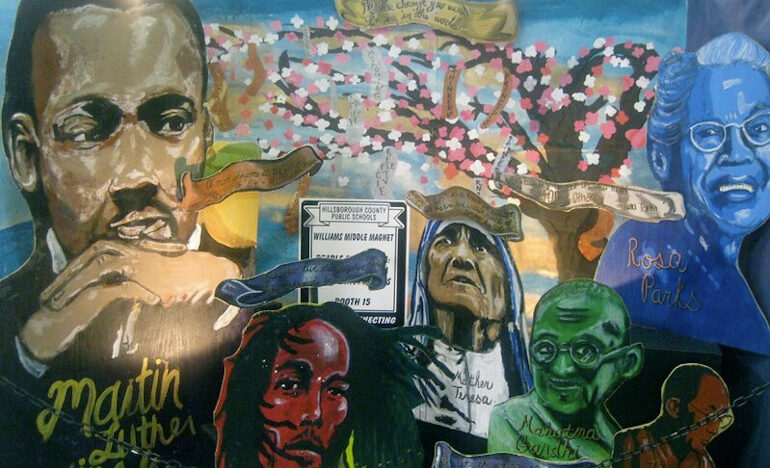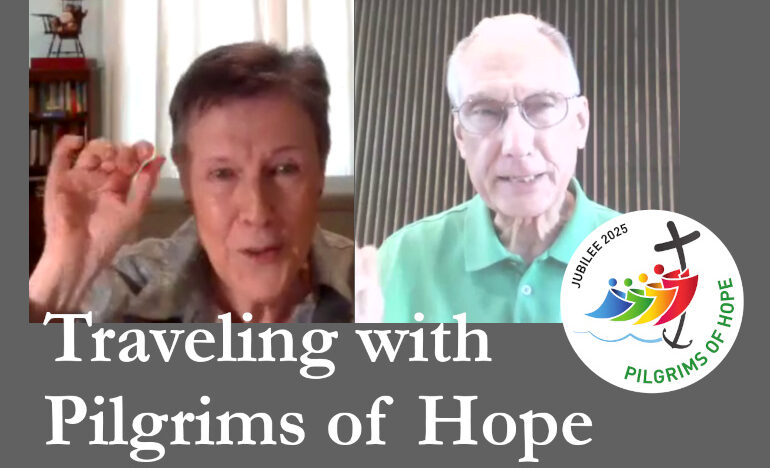Embracing Unity: Teachings of Jesus and the Buddha

by Kathy Keary
Part 3. Read all the parts here.
As we continue our focus on nonviolence, alarming unrest surrounds us disturbing a sense of peace in our country and throughout the world. Amid this turmoil and dysfunction, we honor Reverend Dr. Martin Luther King, Jr.
Dr. King, a Baptist minister, civil rights leader, and peace activist, is a reminder that God has raised up voices of nonviolence throughout history and among diverse faiths calling us to our better angels.
King’s stance of nonviolence was inspired by Mohandas K. Gandhi who grew up in India in a religious atmosphere of Hinduism and Jainism. Gandhi was influenced by many faith traditions including Christianity, Buddhism, and Islam. The Martin Luther King, Jr Research and Education Institute at Stanford University describes King as “the first person to transform Christian love into a powerful force for social change.” King stated that Gandhi’s emphasis on love and nonviolence gave him the method for social reform that he had been seeking.
Violence stands in opposition to the call to unity and harmony among the people of God. The topic of unity among all people is a common theme in the religions of the world.
New articles in this series are posted to the website every Monday. The full series can be found here: An Invitation to Something New: The Contemplative Life. On Thursday’s we’ll send an email to remind you of the articles.
In the Christian tradition, we believe that everyone is created in the image and likeness of God. We consider everyone as children of God and each individual as our sister or brother in Christ. This familial relationship speaks of the divine intent for unity among the people of God. Embracing unity on a spiritual level is a key ingredient to a stance of nonviolence.
Jesus spoke of unity throughout his public life, and the message of unity permeates the New Testament. In the Gospel of Matthew, to take just one example, Jesus warns: “Every kingdom divided against itself will be laid waste, and no town or house divided against itself will stand” (12:25).
Thomas Merton, a Trappist monk of the 20th century, eloquently summarized the Christian stance of unity:
The more I become identified with God, the more will I be identified with Him. His Love will live in all of us. His Spirit will be our One Life, the life of all of us and the Life of God. And we shall love one another and God with the same Love with which He loves us and Himself. This love is God Himself. Christ prayed that all men [and women] might become One as He was One with His Father, in the Unity of the Holy Spirit … The ultimate perfection of the contemplative life is not a heaven of separate individuals, each one viewing his own private intuition of God; it is a sea of Love which flows through the One Body …
A call to unity is also a common theme in Buddhism. Wadigala Samitharathana of Sri Lanka explains in his insightful article “Buddhist Teachings Towards Unity and Harmony” that Buddhist teachings provide sustaining ideas to achieve world peace:
People should learn to live together with mutual respect, understanding, help and caring for each other’s benefit. … The Buddha often preached about the need and desirability of harmony within and among groups of people … Buddha’s teaching is a conventional approach for solving social conflict by understanding, compassion, non-violence and peace. … The Buddha advised his followers not to hurt, curse or injure any living species in the world. … This requires human dignity and kindness without discrimination … The development of inner peace would lead to reconcile harmony and unity among people.
The Buddhist monk Thich Nhat Hanh created the concept of interbeing during the Vietnam War to quiet the hatred, violence, and divisiveness that enveloped his country. Traditional Buddhist morality merged with the social concerns of the day.
Interbeing is based on traditional Buddhist thinking that says that all phenomena are interdependent. Any person or thing is dependent on all other persons and things. He taught that “the verb ‘to be’ can be misleading, because we cannot be by ourselves, alone.” He coined a new verb to better reflect this teaching: “interbeing.”
In his article “The Insight of Interbeing,” Thich Nhat Hanh writes, “We inter-are with one another and with all life. … Everything relies on everything else in the cosmos in order to manifest — whether a star, a cloud, a flower, a tree, or you and me.”
Note: Never miss an article published on the Renewal Center website: Sign up to receive our newsletters
In his book, living Buddha, living Christ, Thich Nhat Hanh connects the concept of interbeing with maintaining harmony with one another: “When we see the nature of interbeing, barriers between ourselves and others are dissolved, and peace, love and understanding are possible. Whenever there is understanding, compassion is born.”
Stay tuned for our next article where we will explore practices in the Christian and Buddhist traditions that support and encourage peace and nonviolence. In the meantime, let us pray for the grace to stand with the voices that seek unity. May we be instruments of peace, nonviolence, and unity in our world.
[Kathy Keary, a Precious Blood Companion and spiritual director, holds a master’s degree in theological studies and is a graduate of the Atchison Benedictine’s Sophia Center’s Souljourners Program, an intense study of spirituality and spiritual direction. Kathy believes that the divine is present and active in all of life and encourages others to be awakened to the God in all including the divine within. She enjoys accompanying others on their journey to wholeness discovering the person they were created to be.]
Image above “Williams Middle Magnet: Champions of Freedom” by giveawayboy is licensed under CC BY-NC-ND 2.0
References
Hanh, Thich Nhat. living Buddha, living Christ. New York, New York: Riverhead Books, 2007.
Hanh, Thich Nhat. 2017. “The Insight of Interbeing.” Garrison Institute Newsletter, 8/2/17. www.garrisoninstitute.org/blog/insight-of-interbeing. Accessed 1/16/21.
The Martin Luther King, Jr Research and Education Institute, Stanford University. “Nonviolence.” https//kinginstitute.standford.edu/encyclopedia/nonviolence. Accessed 1/16/21.
Merton, Thomas. New Seeds of Contemplation. Kentucky: Abbey of Gethsemani, Inc, 1961.
Samitharathana, Wadigala. 2019. “Buddhist Teachings toward Unity and Harmony.” Sunday Observer, 10/27/19. www.sundayobserver.lk/2019/10/27/places/buddhist teachings-toward-unity-and-harmony. Accessed 1/16/21.
We’d Like to Hear From You!
We’d like to know what you think about this article. Send us a comment using the form below. Do you have a suggestion? Is there something you want to learn more about? Send us a note.
Related

Take Nothing for the Journey
An Assembling God’s Puzzle video
By Fr. Garry Richmeier, C.PP.S.
Jesus’ teaching about what to take on a journey — nothing — is actually good advice for building trusting relationships. Don’t bring your “stuff” into the relationship; listen deeply and respec their views and situation, understand their struggles.

Pilgrims of Hope, Episode 6: Walking with Cancer Survivors
Hosted by Fr. Ron Will, C.PP.S.
We are talking with people who find hope amid difficult circumstances or bring hope to others. In this episode, Kathy Keary talks about how centering prayer, journaling and other spiritual practices helped her cope with two life threatening health issues.
Categories
Assembling God's Puzzle Coffee with Padre Cooking & Spirituality Encounters of the 4th Kind Family Matters Reflections on the Eucharsitic Prayers Spiritual Resources Taize Prayers The Contemplative Life Traveling with Pilgrims of Hope Uncategorized Videos Week of Prayer for Uhristian Unity When you need a little help
